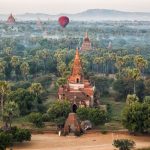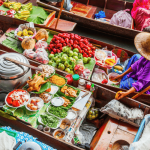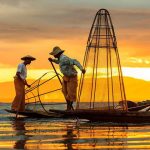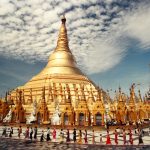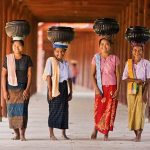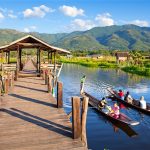By Simon Richmond, Writer
It doesn’t matter whether this is your first or 51st visit to Myanmar: you won’t fail to notice the energy, hope and possibilities for the future that hang in the air. Exiles are returning, joining others in rising to the challenge of bringing their country into the 21st century at the same time as preserving the best of the past. Myanmar has many problems to fix, but its people remain as stoic and charming as ever. Slow down, sit, listen and connect with them – it’s the best way to appreciate what’s truly golden about this land.
Money
The official currency in Myanmar is the Burmese kyat (MMK).
Pronounced something like ‘chee-at,’ the Burmese kyat is often abbreviated as ‘K’ or ‘Ks.’ The most common denominations encountered by travelers are 5,000-kyat and 1,000-kyat banknotes. Some ATMs dispense 10,000-kyat banknotes that can be difficult to break. Smaller denominations received in change include 500, 200, 100, and sometimes worn-and-ratty 50-kyat banknotes.
Important Note: Myanmar is changing so quickly that much of the information you find online is already obsolete.
You’ll find ATMs plastered with all of the usual card logos in nearly all tourist areas. Even still, you should load up on local currency in bigger cities before heading farther afield where ATMs can run out of cash or experience network problems. ATM’s dispense kyat rather than U.S dollars.
Some tips for using ATMs in Myanmar:
-
Stick to using ATMs attached to bank offices in case the machine captures your card.
-
The standard fee for a transaction is 5,000 kyat (around US $5).
-
Choose an odd amount to ensure that you receive at least a few smaller-denomination banknotes. For instance, don’t request 100,000 kyat which may yield 10 hard-to-break 10,000-kyat notes. Instead, try asking for 95,000 kyat.
Eating and Drinking
Burmese food suffers from an undeservedly bad rap. While the country’s cuisine can be oily, and it lacks the diversity of the food of neighbouring Thailand, with a bit of pointing in the right direction and some background knowledge, you’ll almost certainly return from Myanmar having savoured some truly tasty and memorable meals.
It’s rarely necessary to book a table when eating out in Myanmar. Bookings are usually only required for top dining spots in Yangon and other major tourist centres at peak travel times, eg Chinese New Year.
- Cafes and teahouses Simple cafes and teahouses are the most common places to eat a meal across Myanmar.
- Restaurants Outside major urban centres, fancy restaurants are a rarity. If they’re not serving Burmese food, it will usually be Chinese or possibly Indian.
- Street food Very common across Myanmar and can be excellent, but hygiene can be a problem.
Drinks
Black tea, brewed in the Indian style with lots of milk and sugar, is ubiquitous and cheap, costing K300 to K400 per cup at the time of research. Most restaurants and tea shops also provide as much free Chinese tea as you can handle.
International and local-brand soft drinks are widely available. Real coffee can be found at a steadily increasing number of modern Western-style cafes in Yangon and other large cities. Elsewhere, coffee drinkers might find themselves growing disturbingly attached to the ‘three-in-one’ packets of instant coffee (the ‘three’ being coffee, creamer and sugar); you can have these in teahouses for about K200.
Drinking Water
Drink water in Myanmar only when you know it has been purified – which in most restaurants it should be. Ice in drinks bought in beer stations and bars is normally fine. Be more suspicious of ice from street stalls. Many brands of drinking water are sold in bottles and are quite safe, but check the seal on the bottle first. A 1L bottle, usually kept cool by ice or refrigerator, costs K400 to K500.
Alcoholic Drinks
Myanmar’s alcohol-drinking culture is all about ‘beer stations’, the Burmese version of pubs or bars. Found in every city and town, these rough-and-ready places serve cheap draught beer as well as local whisky and rum. Often they have kitchens that whip up noodle and rice dishes and Burmese beer snacks such as salads and barbecue; in small towns, beer stations are sometimes the only dining-out options. They’re key spots for watching football, and so are busiest at weekends and when a big match is on. It’s a predominantly male scene – many Burmese women regard beer stations as disreputable – but foreigners are nearly always welcomed with a smile. Note that you’ll sometimes see children working as waiters in beer stations.
In Yangon, you’ll find some sophisticated cocktail bars that cater to foreigners and cashed-up locals.
Beer
While a craft-beer scene is a long way off, the opening up of Myanmar’s economy has led to a broadening of what’s available to beer drinkers. Japanese beverage giant Kirin has taken a 55% stake in Myanmar Brewery Limited, producer of the top-selling Myanmar Beer. Its standard (green-label) product is slightly lighter in flavour and alcohol (allegedly 5%) than other Southeast Asian beers and costs around K800 a draught pint. Its Premium brand is more wheaty and uses imported malt. The company also has a couple of other brands, including Black Shield stout.
Carlsberg and Heineken have also come into the market with their own brands and local variations, such as Yoma and Regal 7. At fancier urban bars you’ll also find imported beers.
Liquors & Wines
Very popular in Shan State is an orange brandy called shwe leinmaw. Much of it is distilled in the mountains between Kalaw and Taunggyi. It’s a pleasant-tasting liqueur and packs quite a punch.
Near Taunggyi a couple of vineyards make wine, and in Pyin Oo Lwin there are several sweet strawberry-based wines.
There are also stronger liquors, including Burmese-style whiskies (the most popular brand is Grand Royal) and ayeq hpyu (white liquor), which varies in strength from brandy-like to almost pure ethyl, and taw ayeq (jungle liquor), a cruder form of ayeq hpyu. Mandalay is well known for its rums, and there’s also the fermented palm juice known as toddy, which is weak in alcohol.
Tipping
Tips are very common in Asia, but not generally in Myanmar. For waiters, luggage porters, maids, bus drivers, taxi drivers and tour guide gratuities are a nice addition to their meager wages. The bus driver expects a tip for the time in which they drive you, at least if they have done their work satisfactorily (guideline: US 0.50 per passenger per day). This also applies to the tour guide, of course if she/ he has done well. Our guide to this tip is US 1 per passenger per day.
Australian Government Travel Advice
The Australian Government provides up to date information on the safety of travelling to various countries, and all travellers should take note of this advice. Liberty Tours recommends that all travellers take out appropriate Travel Insurance to cover the entire duration of their absence from home. Liberty Tours can assist with obtaining Travel Insurance.
https://www.smartraveller.gov.au/destinations/asia/myanmar
Follow this link for current official assessment:
Advice on health risks and vaccination recommendations can also be found using the same link.
Weather
High Season (Dec–Feb)
- The rainy season is over and it’s not so hot.
- Book accommodation and transport well ahead for this busy travel period.
Shoulder (Oct & Nov, Mar & Apr)
- From March to May, Yangon often reaches 104ºF (40ºC). Areas around Bagan and Mandalay are hotter. It’s cooler in the hill towns of Shan State.
- All forms of transport are booked solid during Thingyan in April.
Low Season (May–Sep)
- The southwest monsoon starts in mid-May and peaks from July to September.
- The dry zone between Mandalay and Pyay gets the least rain. Rain can make roads impassable in the more remote areas.
What to pack
In winter: in the north (see Myitkyina, Mandalay), and in cities located at middle or low-mountain altitudes (Taunggyi, Kengtung), bring spring/autumn clothes (light for the day), a jacket and a sweater for the evening, and a hat and a scarf for cooler evenings. Along the coast, bring light clothing, a light sweatshirt for the evening, and a scarf for the breeze; in the northern part of the coast, up to Yangon, you can add a light jacket or a sweater for cooler evenings. In the Himalayas, bring mountain clothing, and hiking boots.
In summer, bring lightweight clothing of natural fibers, a light raincoat or umbrella, and comfortable shoes. You can add a light sweater for the evening at low-mountain altitudes; in the Himalayas, bring warm clothes, a raincoat, and hiking boots.
Before entering pagodas, it is customary to take off shoes, dress neatly and cover a little. It’s better for women to avoid shorts and miniskirts.

